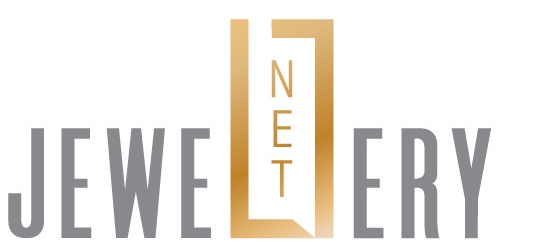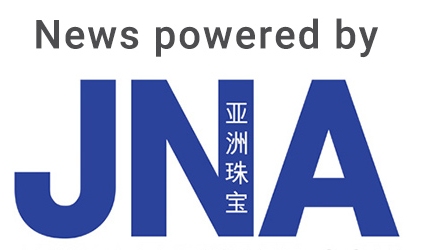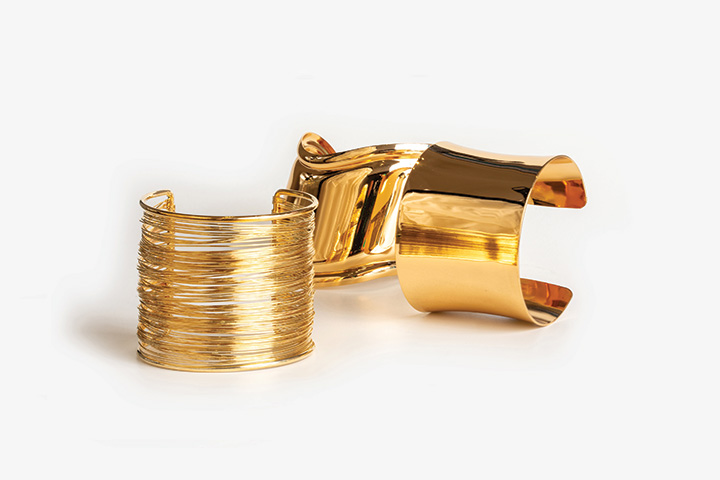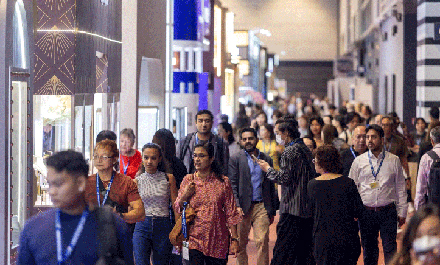The jewellery and gemstone trade successfully navigates market challenges through innovative initiatives and demonstrated tenacity and perseverance.
This article first appeared in the JNA November/December 2025 issue.
Jewellers are describing the year 2025 as very challenging, with multipronged, widespread risks affecting business across the value chain – from mining and manufacturing to retail.
Topping the list of unfortunate events derailing growth in the trade are US tariffs, first announced by US President Donald Trump on April 2. The US tariff scheme has since undergone various iterations, with some items still on the negotiating table.
The impact, however, has been palpable. The 10 per cent base levy on all imports that remains in force alongside country-specific tariffs have hurt shipments of jewellery, gemstones and other related materials to the US market.
India, a top exporter of gems and jewellery to the US, currently faces a 50 per cent tariff, but this could still change as trade negotiations ensue. Other major jewellery and gemstone hubs also face steep levies: Thailand, 19 per cent; Turkey, 15 per cent; Brazil, 50 per cent; and Sri Lanka, 20 per cent, to name a few.
In September, the Antwerp World Diamond Centre (AWDC) announced that polished diamonds from Europe entering the US will no longer be subject to the standard 15 per cent tariff as a result of intensive negotiations between the US and the European Commission.
In mid-October, Trump had threatened to impose an additional 100 per cent tariff on products coming from China, a few months after mutually agreeing to drop hefty levies on each other’s goods. A consensus had yet to be reached at press time.
Exacerbating the situation is the unprecedented rise in the price of gold, which reached its 45th new all-time high of 2025 at US$4,000 per ounce on October 8, revealed the World Gold Council. Prices rose to above US$4,000/oz from US$3,500/oz in just over a month. Gold was priced at US$4,082.51/oz as of October 22, 2025.
A lot of moving parts are also in play, including economic and geopolitical tensions. It is all seemingly catastrophic for jewellers – having to contend with ongoing volatility, pricier gold alongside additional costs when shipping goods to the US, the world’s largest jewellery market. The impact was felt at recently concluded trade shows, with exhibitors in Hong Kong and Turkey saying buyers are wary of placing orders.
Overall business sentiment remains lacklustre too, with many industry players opting for caution as global uncertainties continue to unfold in the trade.
Amid a tough scenario, however, jewellery and gemstone companies are rising above adversity by implementing fresh strategies, finding new markets and working together as a unit – empowered by collective resilience.
Market adjustments
Trade buyers are grappling with the effects of high gold prices coupled with economic and political upheavals, shared Cedric Garnier, managing director of fine jewellery manufacturer Sofragem Co Ltd.
The second half of the year has been particularly difficult because of the tariff issue, he added.
Heavily affected by gold prices, meanwhile, are manufacturers of medium-range pieces while companies producing mass-market items are gradually shifting to other metals and lab-grown diamonds. Top-quality, one-of-a-kind jewellery pieces continue to sell.
Alexander Sokolov, co-owner of Mousson Atelier, explained that retailers are increasingly becoming cautious due to market instability and would refuse to accept current prices of goods. Instead, some are insisting on buying on consignment.
“It is quite a challenge. However, manufacturers like us continue to produce jewellery even with high gold prices,” he added.
Abhishek Rawat, director at Lume Creations Co Ltd, agreed with Garnier that high-end jewellery pieces are performing strongly amid volatile market conditions.
“Premium-quality jewellery and innovative designs remain in demand,” he noted. “For instance, jewellery pieces valued at US$4,000 to US$5,000 at wholesale, which are around US$10,000 at retail, are moving particularly well.”
Buyers are also regularly enquiring about big-ticket items while inventive collections are gaining a great deal of interest. This signals steady momentum and a stark improvement from the beginning of the year, added Rawat.
More importantly, this could mean that the industry is heading in a positive direction, with important shopping occasions such as Christmas, Chinese New Year and the wedding season in India on the horizon.
Gold jewellery enjoyed robust demand in 2025, according to Sharon Weng, deputy brand director of China-based Shenzhen Yuehao Jewellery Co Ltd. Its broad selection of gold jewellery pieces, which include 24-karat hard pure gold, was well received, driven by innovative designs. The company also offers diamond and coloured gemstone jewellery.
This reflected potential recovery in the broader jewellery market in China where gold is a dominant player, according to Weng.
Among Yuehao Jewellery's bestsellers are 24-karat gold pieces that incorporate unconventional materials such as wood and feathers – an experimental fusion that appeals to fashion-forward consumers seeking individuality.
Felix Chen, president and CEO of PAJ Group, said the jewellery industry has changed tremendously in 2025 due largely to Trump’s protectionist policies. Business was bouncing back strongly in 2024 after the pandemic, but the US tariffs put the brakes on progress. The company manufactures mostly silver jewellery.
“The challenge has not so much been the tariffs themselves but their unpredictable nature,” he explained. “The rates keep changing, making it difficult to plan supply chains and production.”
Fearful of uncertainties and economic downturns, retailers dare not make long-term plans and now wait till the last minute to place orders, he added. Manufacturers must thus increasingly handle urgent orders from their clients, with delivery times often down to two to four weeks compared to eight to 12 weeks in the past.
The global coloured gemstone market, meanwhile, is recalibrating in 2025, marked by varying regional appetites and a widening gap in consumer spending power.
According to Jason Chen, executive director of Germany-based coloured gemstone specialist Chq GmbH, the sector is contending with economic headwinds, particularly a sluggish Chinese market.
Chq, which has manufacturing facilities in Italy, Germany and China, serves a diverse clientele across Asia, Europe and the US. Chen noted that while prices for high-quality coloured gemstones have soared, demand from China and Southeast Asian markets has not kept pace.
Sales of average-quality gemstones are lagging while demand for exceptional, larger gems such as sapphires of 10 to 20 carats and rubies of 5 to 6 carats remains steady.
“Business in 2025 is affected by the global economic downturn. The Chinese economy is particularly sluggish,” he explained. “Chinese buyers continue to seek top-tier rubies, emeralds and sapphires, showing less interest in other gemstones. However, actual purchasing has been slow.”
Meanwhile, demand from the US and Europe holds steady, though sales volumes are primarily driven by commercial-grade or lower-end gemstones.
A critical challenge facing the industry is a fundamental shift in US and European consumer behaviour, especially among younger demographics who are increasingly hesitant to buy expensive jewellery. To address this, Chq is focusing on innovation and customisation.
“Our strategy is to offer more personalised products, including gem cutting and jewellery designs,” Chen said. “These have to be innovative in order to appeal to younger generations.”
Over in the pearl sector, global trade tensions arising from US tariffs, policy uncertainty, inflation and high interest rates are also adding pressure to businesses, according to Terence Lee, director of Hong Kong-based pearl expert Rio Pearl.
These factors were major deterrents to growth in 2025, and jewellery businesses that are heavily reliant on the US and other Western markets were particularly impacted.
“Regardless of markets, consumer spending in general is eroding, and our sector has been hit as well,” explained Lee. “Rio Pearl’s distribution channels, however, are quite diversified, with some of our major buyers located in the Asia-Pacific region. This minimises our exposure to geopolitical risks.”
Paul Rowley, De Beers Group’s senior vice president for Diamond Trading, said things were improving at the start of 2025, with companies seeing some activity and prices stabilising, until US tariffs disrupted business.
Demand in China has since started to rebound, leading to a positive trend at the consumer level. Large retailers were reporting encouraging results, not just around gold jewellery but gem-set pieces as well, with larger sizes starting to move a fair bit. Amid weaker demand, there was also more replenishment and restocking, indicating that the earlier oversupply that distorted the market had eased and goods were moving again.
“China’s economic situation has improved as well, giving consumers greater confidence to purchase luxury goods. Self-purchase is a strong segment, but we hope to see wedding rates pick up too,” he continued.
Rowley also remarked that 2025 was a particularly tough year for the industry.
“This is the one of the most challenging cycles I have seen in my 40 years in the trade,” he noted. “Several factors combined to create a perfect storm: From Covid, the Ukraine war and sanctions on Russian diamonds to the lab-grown proposition, the Middle East conflict and the US tariffs. I do not think we have seen anything this volatile since World War II.”
Next steps
Moving forward, companies could benefit from expansion initiatives. Mousson Atelier's Solokov said he has been travelling frequently to look for new markets and potential clients.
Felix of PAJ, for his part, has put in place various measures to mitigate the impact of US tariffs. Having anticipated the policy shifts of the Trump administration, his company bought a factory in Bangkok to spread out its production capabilities, which were previously concentrated in China. The Bangkok facility now handles most of the orders and fulfilment for the US market.
The company is also witnessing further growth from Eastern Europe and the Middle East as well as the e-tailer segment. The latter is often driven by younger generations of family businesses who are well versed in the logistics and mechanics of e-commerce.
Some manufacturers, meanwhile, are focusing on other precious metals to meet a rising demand for alternatives to gold. Japanese jeweller Kuwayama, for instance, is shining the spotlight on platinum.
“This time around, we are focusing on platinum jewellery, and there has been some promising activity. There seems to be a movement away from gold, which used to be a top performer, but this is changing since gold prices have been skyrocketing,” explained Noriyuki Kamei, Kuwayama's director and head of Overseas Business Development.
Platinum has its own superlative characteristics, too. The metal’s durability, lustre and investment value are attractive to customers looking for a meaningful purchase. Kuwayama’s platinum jewellery for men collection has been moving particularly well, with strong buyer interest in China, Hong Kong, the Middle East and India, added Kamei.
Kuwayama’s major markets are Japan, Thailand, China, Vietnam and the Philippines.
“Onwards to 2026, the economy is getting better, and market momentum is strengthening. India is our main target next year because of its growing demand for platinum chains,” he added.
Associations are likewise implementing measures to assist their members during uncertain times. Tommy Lee, chairman of the Hong Kong Jewellery Manufacturers’ Association (HKJMA), said members are regularly given updates on US tariffs as well as other markets they can tap.
Hong Kong companies are now focusing more on creative designs and communicating with customers on their specific requirements. “As an association, we also talk to banks to explore how they can support us financially during this period of uncertainty,” disclosed Lee.
Lawrence Ma, founding president of the Diamond Federation of Hong Kong, China, cited encouraging signs of economic recovery in China and Hong Kong, particularly in the second half of the year.
“The gem and jewellery industry has had to cope with significant tariff uncertainties this year. All we can do is adjust to the situation. Earlier in the year, the disruption was less pronounced because a lot of diamonds were shipped to the US ahead of the main tariff implementation,” explained Ma.
Temporary measures will continue to be introduced to support jewellery production in the post-tariff era, he disclosed.
Ma is also upbeat about business prospects, adding that the worst is probably over. “The general economic condition will bounce back, except for those exporters who depend on the US market. Interest rates are coming down worldwide and governments are encouraging spending,” he added.
De Beers’ Rowley, meanwhile, expects a positive Thanksgiving and Christmas season in the US amid the tariff issue.
“There are a lot of diamonds onshore in the US. Other markets are likewise active, such as Vietnam, South Korea, the United Arab Emirates, Bahrain and Saudi Arabia,” he remarked. “All in all, I am encouraged that things are moving in the right direction.”
According to Rowley, De Beers has realigned its production and business by removing roughly US$130 million of costs per year, streamlining operations and focusing on new strategies to further strengthen the natural diamond category.
Its new polished division assists clients in sourcing specific stones in the De Beers system while its beacon product, Desert Diamonds, was launched in the US and recently presented in China.
It has also repositioned its jewellery brands: High jeweller De Beers London is opening its flagship store in Paris while Forevermark is now an India-specific brand.
“We now have around 10 Forevermark stores there and are aiming for a hundred throughout the country by 2030,” Rowley revealed.

















